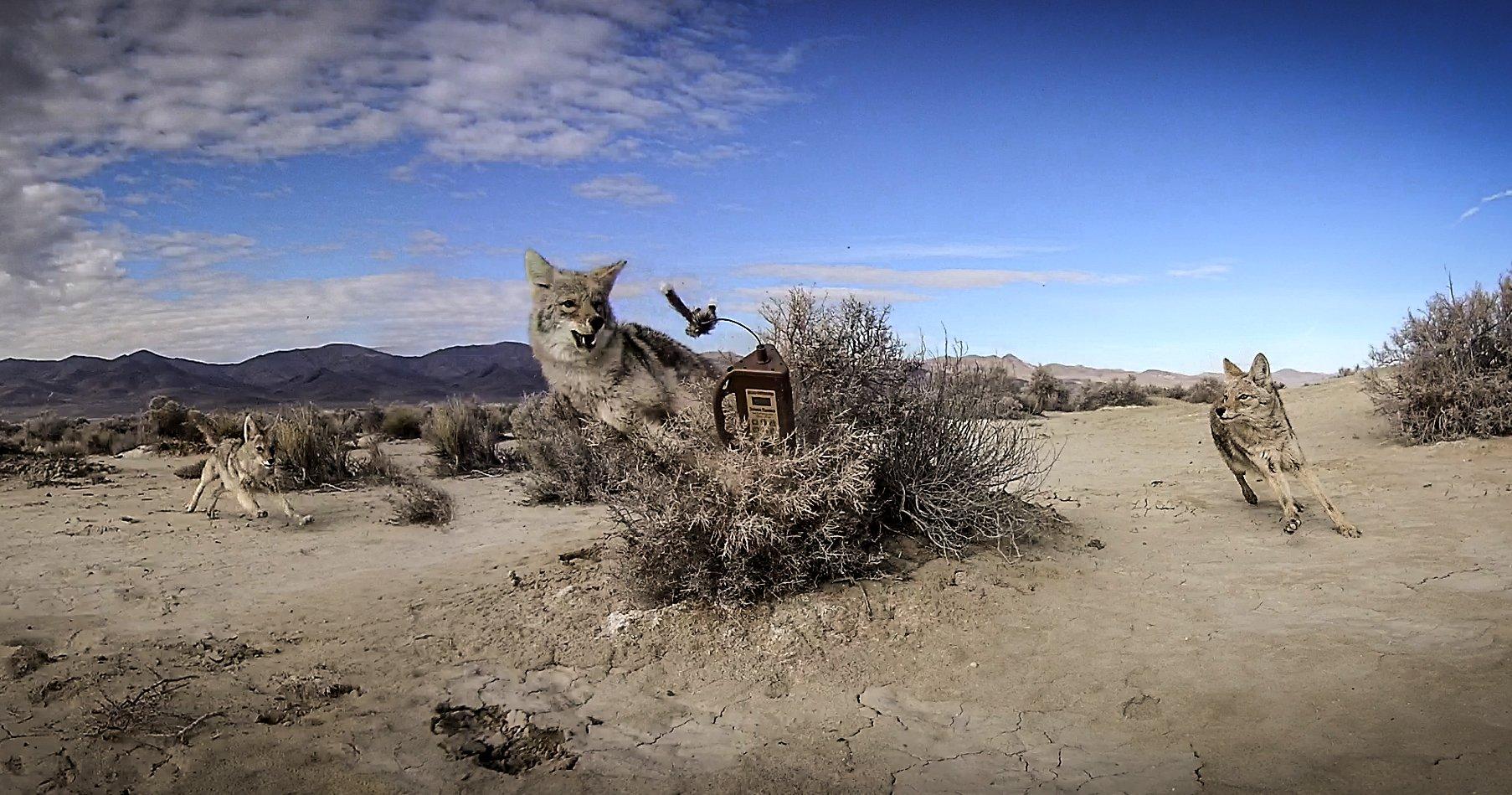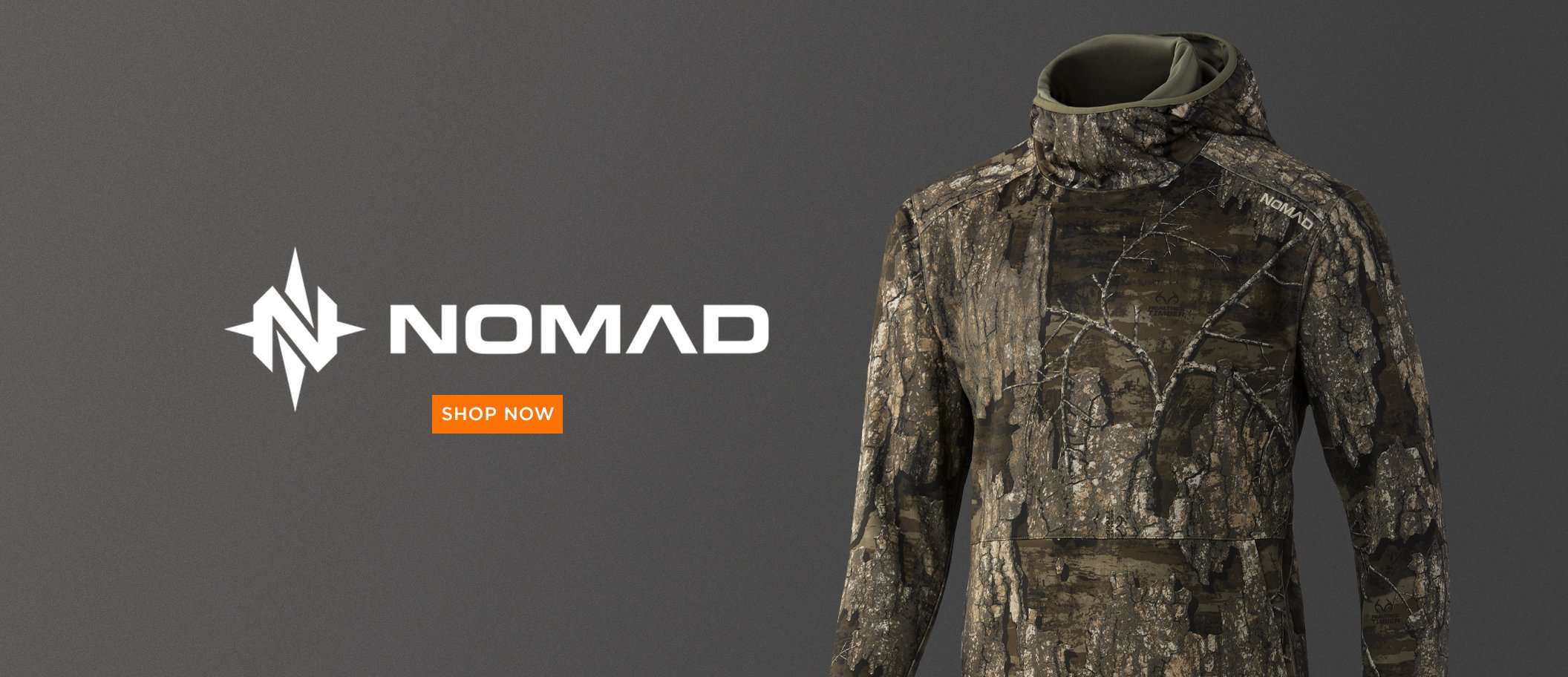A champion contest caller breaks down when to use prey distress, coyote vocals, coyote distress, and curiosity sounds when you’re predator hunting
If you want to be convincing when trying to talk coyotes into coming by for a visit while you’re on stand, you should be telling them something they want to hear.
Look at it this way. Say you’re hungry as you’re walking through a hall with doors open on either side. As you pass the first door you hear a loud conversation about what Taylor Swift was wearing at the Chiefs game, so you keep walking. At the next door, the conversation is about the merits of posting photos on Facebook of every meal you eat, so you shrug and keep on keepin’ on until, from another doorway, you overhear a descriptive conversation about how great the FREE buffet is. You pivot and beeline through the door.

Hearing about something good to eat is often all it takes to bring in hungry guests. Image by TFL Productions/Tom Rassuchine
Coyotes behave much the same way. Hunger is one of four motivational factors, or triggers, that’ll convince them to come to your call. The other triggers are territorial, curiosity, and parental / societal.
So, if you want to talk to coyotes about food, tell them about the buffet of prey species awaiting them just over the hill at the table you’ve set for them. If you want to get them riled-up mad that you’re in their territory, challenge them to a fight. Tell them you’re trespassing in their neighborhood and you’re about to piss on their lawn and raid their refrigerator.

Coyotes are curious and often can’t resist checking out an intriguing sound. Image by Jeff W. Jarrett
If you want to play on their curious nature, tell them something they can’t resist checking out for themselves, like tasty rodent, raucous crow, squabbling raccoons or any what-in-the-world-is-that-racket sound. Or if you want to pull on their parental concerns or social nature, tell them a young coyote is hurting, lost or scared.
TALK LIKE A CHAMPION
You may have thought about all this but I’ll bet Geoff Nemnich has thought about it more. And he’s taken it an important step further, linking each of the triggers to the three categories of sounds he uses in coyote calling, Prey Sounds, Coyote Vocals and Coyote Distress (Pup Distress, Fights, Breeding, etc.). Nemnich, two-time winner of the World Championship Coyote Calling Contest, lays out his sound strategy in his Coyote Craze College (coyotecraze.com), the only predator-hunting school I’ve heard of that combines a day of classroom instruction with two days of putting the instruction to the test in the field.
In the classroom, Nemnich graphs each sound to each trigger, which lays it out something like this:
Prey sounds trigger hunger, curiosity and (dotted line) sometimes territorial responses. Prey sounds include rabbits, birds, rodents, domestic animals, and even big game.
Coyote Vocals trigger curiosity and territorial responses. Vocals include invitation, location / interrogation and challenge howls, plus whimpers, as well as group vocals, group yip howls and the like.
Coyote Distress sounds trigger social / parental, territorial and (dotted line) sometimes curiosity responses. Those include fighting and breeding sounds, pup distress, and even juvenile red fox distress, fox screams, raccoon fights and so forth.
Finally, pure Curiosity sounds mimic a scenario that a coyote just wants to check out, like crows cawing or fighting, magpies on a kill, and like.
Prey sounds trip three of the four triggers, (as do the sounds grouped under coyote distress) so you can see why most coyote hunters rely on prey sounds as their default sounds. Heck, they may not even know why but they know prey-distress sounds seem to produce. Plus, prey-distress sounds are easier to make (or come in a wide array on an electronic call) and safer in the sense the sound of a prey animal in distress is not likely to alarm or scare away a coyote, whereas the wrong coyote distress or coyote vocal sound at the wrong time might send a coyote hightailing over the hill rather than charging in. Dinner invitations are always welcome; distress, fights or coyote talk may send a cautionary or threatening message.
SOUND ADVICE
Nemnich bases the sound sequences he uses on stand on the time of year in the coyote lifecycle and whether he’s hunting pressured coyotes that have heard it all before. Generally speaking, coyote breeding season usually runs from late January through February, perhaps into March, with some variation from north to south and region to region.
Essentially, during the late January to March timeframe, coyote populations are at their lowest, having taken a hit from hunting, trapping, and winterkill. That doesn’t mean you shouldn’t hunt them then; in fact, calling during the breeding season can be effective. Think Coyote Vocals like location/interrogation calls, some whimpers and estrus whines too.

Base calling methods and sound sequences on the time of year and always stay well hidden on stand. Image by TFL Productions/Tom Rassuchine
After a 63-day gestation period, coyote pups hit the ground, usually in early to mid-April (again with regional variations), so overall coyote populations soar to their peak, but the pups remain den-bound or nearby during whelping and rearing season. Hunting pressure usually is at its lowest at this time as sport and fur hunters generally hold off hunting coyotes until they get older and can respond on their own. Still, those out to dent predator populations in the spring can use Coyote Vocals and Coyote Distress sounds to play on parental instincts.
At three or four months, the year’s young coyotes are like teenagers, venturing out on their own – and getting pushed out on their own. And come September and October, boy howdy, there is a confluence of high adolescent coyote numbers on the prowl just as hunting pressure begins to increase. Savvy hunters know young coyotes translate to callable coyotes, plus many hunters who are afield for other game are more than willing to shoot coyotes when the opportunities arise. That all means that in the fall, you should throw the kitchen sink at them, particularly Prey and Coyote Distress Sounds, and play on the ever-present hunger pangs as well as familial/parental ties. But stay away from dominant or challenging howls, as those are likely to make young coyotes balk or skedaddle.
Coyote hunting and trapping activity generally picks up as colder temperatures prompt fur growth and continues through the winter. There’s another bump in hunting activity in December, January, and February as other hunting seasons end and hunters look for other huntable critters. Accordingly, coyote numbers continue to drop in those months and the cycle begins again.
ON STAND
Classroom learning is one thing, but learning by doing sticks. So, let’s follow Nemnich to the stand.
He starts each calling sequence with less aggressive sounds and builds to a finish with extremely aggressive sounds. Each sequence begins at a low volume, and Nemnich gradually increasing it over the first minute of calling. He’ll predetermine the volume needed before he starts calling, and gets to that desired volume within one minute. More volume is needed on windy days or in big, wide-open country where you can see forever; less volume is needed on low-visibility days or in tight cover.
Don’t Miss: SPRING 2024 SNOW GOOSE HUNTING FORECAST
The least amount of time Nemnich will spend on a stand is six minutes; the most is 18, and between two and eight minutes seems to be the sweet spot when he kills the most coyotes. A coyote can trot at about 10 mph, he said, and though few coyotes probably come from a full mile, they can cover that mile in 6 minutes at a slow trot. A coyote that’s closer, or runs in, gets there faster. Bottomline, a coyote that responds usually responds quicker than you think.
The more visibility from the stand, the less time Nemnich will spend there, figuring he can see for a long distance and will pick up anything coming in from way out there. The less visibility, the more time he’ll spend in case something’s coming in and he just can’t see it just over the hill or in the brush.

Choosing stands with good visibility allows the shooter to see coyotes coming in from long distances. Image by TFL Productions/Tom Rassuchine
Nemnich will move from sound to sound so he covers more than one response trigger at each stand; at a minimum he plays two different sounds and on many stands, he’ll cover four different sounds with a trigger for all four categories. For instance, he’ll start with a subtle cottontail distress sound (hunger) for three, maybe five, minutes. He’ll increase the aggression and appeal to curiosity three or four minutes in with bird sounds; then he’ll try coyote pups (parental/social). If that hasn’t brought in young or eager coyotes, he might go back to prey distress sounds for a couple more minutes before finishing with something on the loud and rowdy end of the scale. A crazy aggressive sound like a coyote-raccoon fight hits the territorial trigger, and Nemnich has called up a ton of coyotes with that sound late in his stands, he said.
***Don’t Miss: *VIRAL VIDEO SHOWS COYOTE HOWLING FROM ATOP CAR AT DEALERSHIP
And he does not repeat a sound category. For instance, if he starts with a cottontail distress and doesn’t get a response, he doesn’t switch to a jackrabbit distress. He says that’s a waste of time. If the cottontail distress call didn’t trigger a hunger, curiosity or even territorial response there’s no reason to believe another prey-distress sound will either. Instead, jump to another category, like Coyote Vocals or Coyote Distress, and see if that trigger is the one that works. When it comes to successfully calling coyotes, telling them what they want to hear at the moment in a language they understand is the key.











